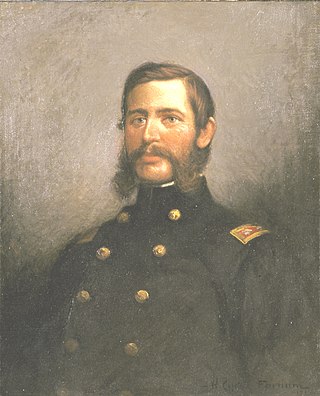
The Battle of Glendale, also known as the Battle of Frayser's Farm, Frazier's Farm, Nelson's Farm, Charles City Crossroads, New Market Road, or Riddell's Shop, took place on June 30, 1862, in Henrico County, Virginia, on the sixth day of the Seven Days Battles of the American Civil War.
Norman Jonathan Hall was an officer in the United States Army during the American Civil War. He commanded the successful defense of his sector of the Union line against Pickett's Charge during the Battle of Gettysburg.

Alanson Merwin Randol was a career United States Army artillery officer and graduate of the United States Military Academy at West Point who served in the American Civil War. He was promoted multiple times for gallant and meritorious service in battle, rising during the course of the war from the rank of second lieutenant to brevet brigadier general of volunteers.
Battery K, 1st Ohio Light Artillery was an artillery battery that served in the Union Army during the American Civil War.

Battery D, 1st Rhode Island Light Artillery Regiment was an artillery battery that served in the Union Army during the American Civil War.
Battery E, 1st Rhode Island Light Artillery Regiment was an artillery battery that served in the Union Army during the American Civil War.

1st Connecticut Heavy Artillery Regiment was an artillery regiment that served in the Union Army during the American Civil War.
Battery "C" 5th Regiment of Artillery was a light artillery battery that served in the Union Army during the American Civil War.
Battery I, 1st Regiment of United States Artillery was a field artillery battery of the United States Army between 1821 and 1901 that notably served in the Union Army during the American Civil War.
The 3rd Independent Battery, New York Volunteer Light Artillery or New York Independent Light Artillery was an artillery battery that served in the Union Army during the American Civil War.
Battery "G" 2nd Regiment of Artillery was a light artillery battery that served in the Union Army during the American Civil War.
Battery "G" 1st Regiment of Artillery was a light artillery battery that served in the Union Army during the American Civil War.
Battery "D" 5th Regiment of Artillery was a light artillery battery that served in the Union Army during the American Civil War.
Battery "K" 5th Regiment of Artillery was a light artillery battery that served in the Union Army during the American Civil War.
Battery "K" 1st Regiment of Artillery was a light artillery battery that served in the Union Army during the American Civil War.
Battery "G" 4th Regiment of Artillery was a light artillery battery that served in the Union Army during the American Civil War.

The 117th New York Infantry Regiment was an infantry regiment in the Union Army during the American Civil War.

Henry Benson was a career United States Army artillery officer who served in the Mexican–American War, Third Seminole War, and American Civil War with the 2nd U.S. Artillery. He sustained mortal wounds on August 5, 1862 during an engagement at Malvern Hill near the end of the Peninsula Campaign, and died several days later on August 11 while being transported north aboard the steamer S.R. Spaulding.

The 2nd U.S. Artillery, Battery E was an artillery battery that served in the Union Army during the American Civil War. The unit fought at the battles of First Bull Run in 1861 and Yorktown, the Seven Days, Second Bull Run, Chantilly, Antietam, and Fredericksburg in 1862. The following year, Battery E moved to the Western Theater where it served at Vicksburg and Knoxville. In 1864, the unit transferred back to the Eastern Theater where it fought at the Wilderness, Spotsylvania, Totopotomoy, and Cold Harbor. For the rest of the war, it became part of the Washington D.C. garrison.

Marcus Peter Miller was a career officer in the United States Army. A Union Army veteran of the American Civil War and a U.S. Army veteran of the American Indian Wars, Spanish–American War, Philippine–American War, he served from 1858 to 1899, attained the rank of brigadier general, and was commended for gallantry during several Civil War battles, the Modoc War, Nez Perce War, and the Iloilo campaign of the Philippine–American War.








